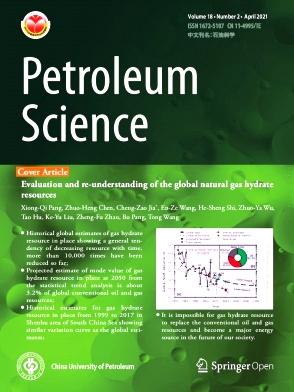Three-dimensional fracture space characterization and conductivity evolution analysis of induced un-propped fractures in shale gas reservoirs
IF 6
1区 工程技术
Q2 ENERGY & FUELS
引用次数: 0
Abstract
Huge numbers of induced unpropped (IU) fractures are generated near propped fractures during hydraulic fracturing in shale gas reservoirs. But it is still unclear how their fracture space and conductivity evolve under in-situ conditions. This paper prepares three types of samples, namely, manually split vertical/parallel to beddings (MSV, MSP) and parallel natural fractures (NFP), to represent the varied IU fractures as well as their surface morphology. Laser scan and reconstruction demonstrate that the initial fracture spaces of MSVs and MSPs are limited as the asperities of newly created surfaces are well-matched, and the NFPs have bigger space due to inhomogeneous geological corrosion. Surface slippage and consequent asperity mismatch increase the fracture width by several times, and the increase is proportional to surface roughness. Under stressful conditions, the slipped MSVs retain the smallest residual space and conductivity due to the newly sharp asperities. Controlled by the bedding structures and clay mineral hydrations, the conductivity of MSPs decreases most after treated with a fracturing fluid. The NFPs remain the highest conductivity, benefitting from their dispersive, gentle, and strong asperities. The results reveal the diverse evolution trends of IU fractures and can provide reliable parameters for fracturing design, post-fracturing evaluation, and productivity forecasting.
页岩气储层中诱导性未挤压裂缝的三维裂缝空间特征和电导率演化分析
本文章由计算机程序翻译,如有差异,请以英文原文为准。
求助全文
约1分钟内获得全文
求助全文
来源期刊

Petroleum Science
地学-地球化学与地球物理
CiteScore
7.70
自引率
16.10%
发文量
311
审稿时长
63 days
期刊介绍:
Petroleum Science is the only English journal in China on petroleum science and technology that is intended for professionals engaged in petroleum science research and technical applications all over the world, as well as the managerial personnel of oil companies. It covers petroleum geology, petroleum geophysics, petroleum engineering, petrochemistry & chemical engineering, petroleum mechanics, and economic management. It aims to introduce the latest results in oil industry research in China, promote cooperation in petroleum science research between China and the rest of the world, and build a bridge for scientific communication between China and the world.
 求助内容:
求助内容: 应助结果提醒方式:
应助结果提醒方式:


